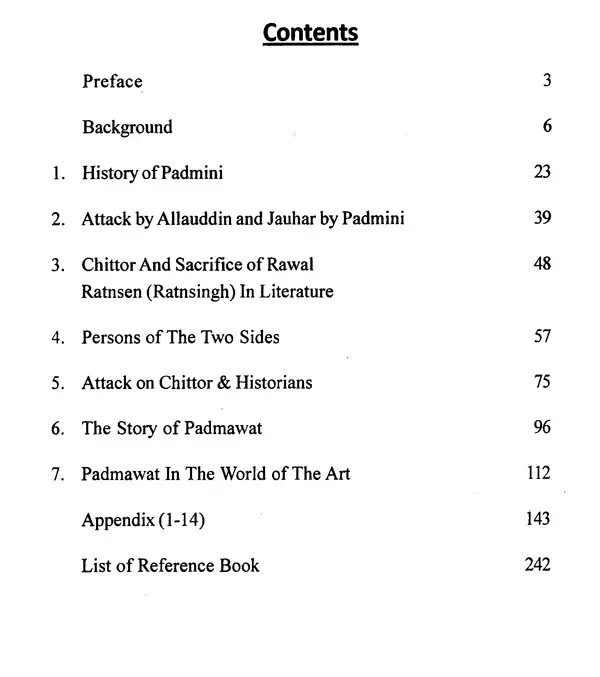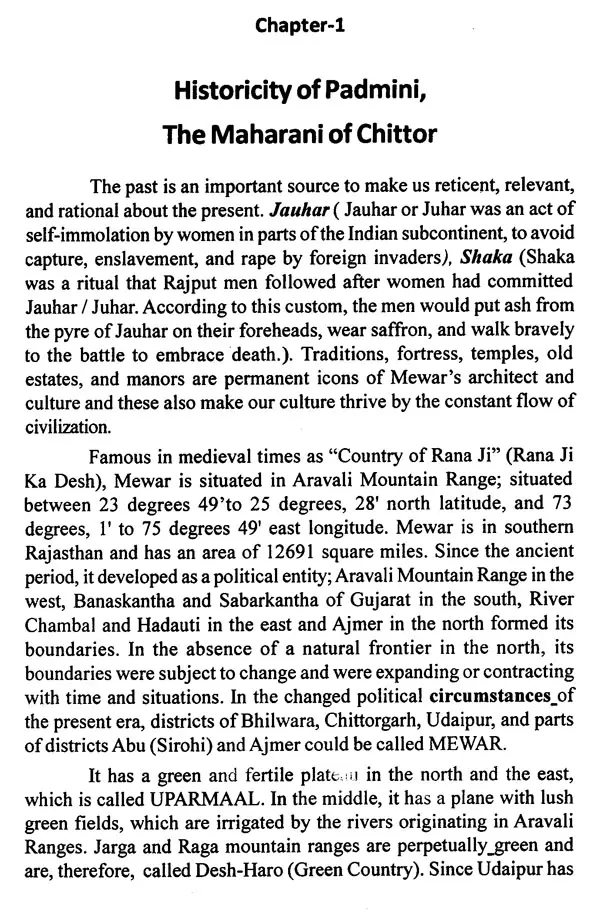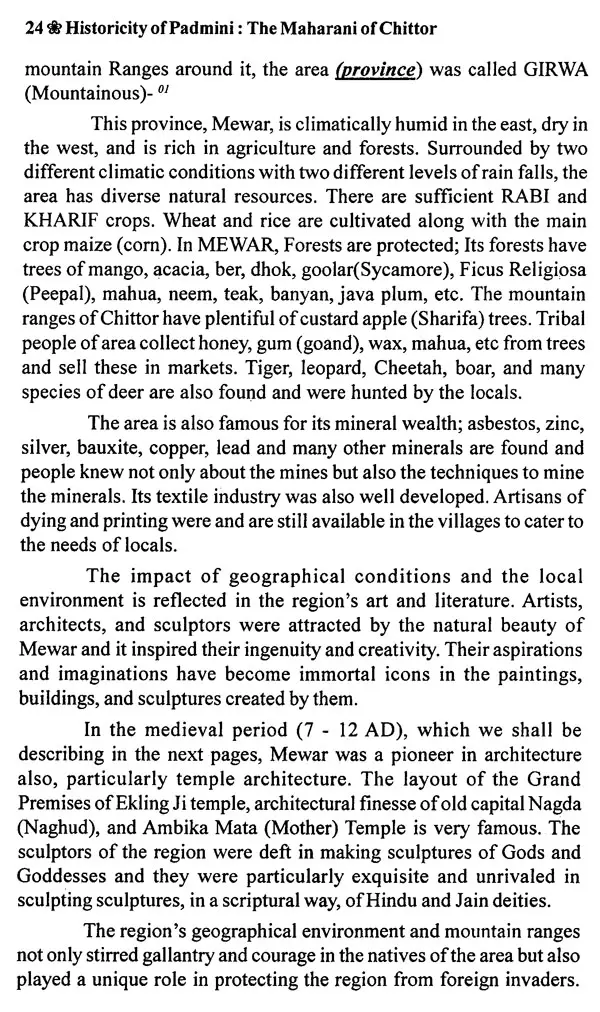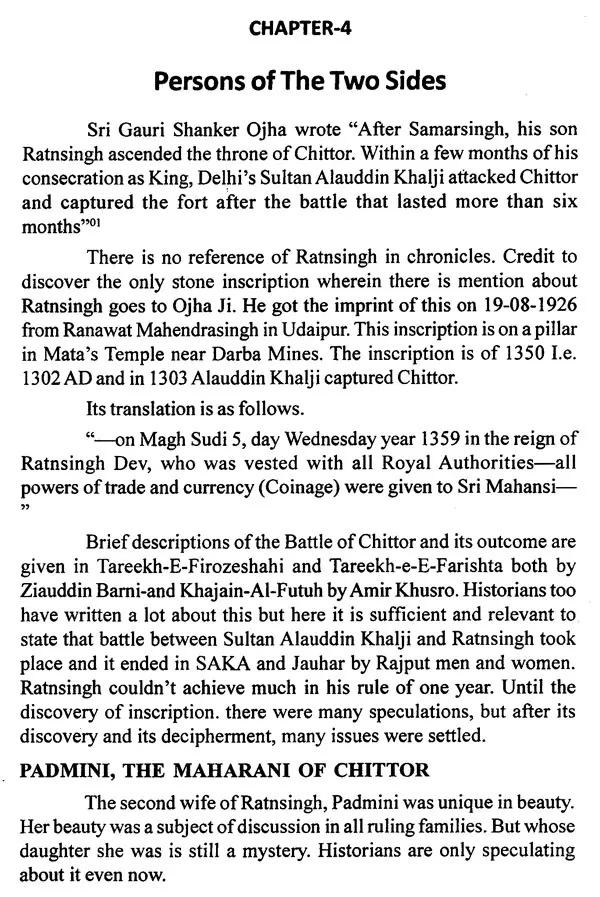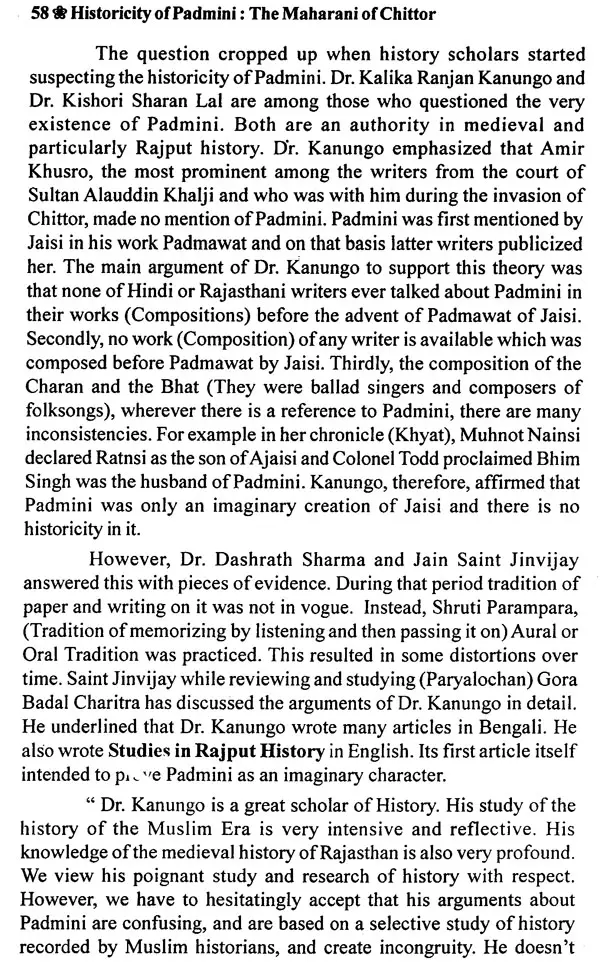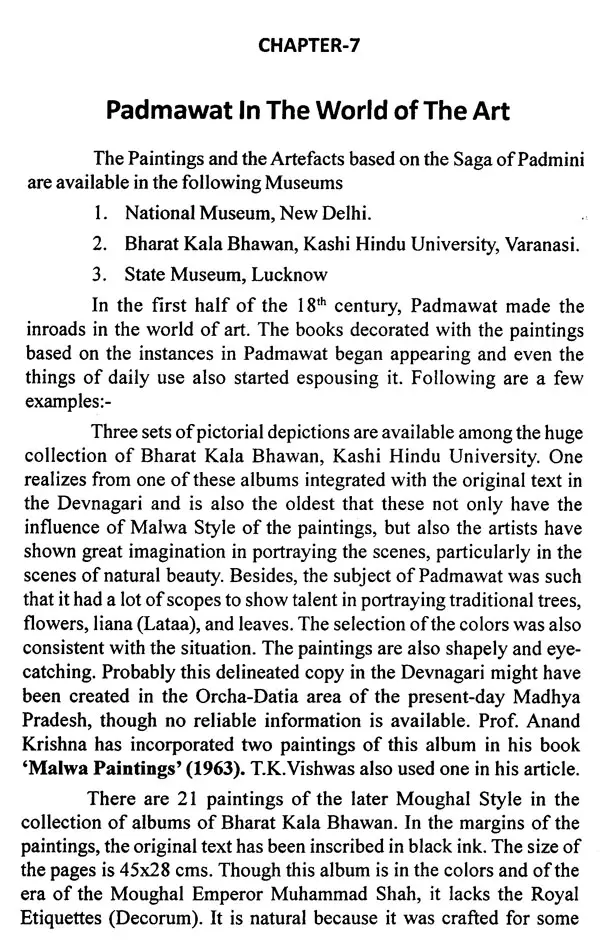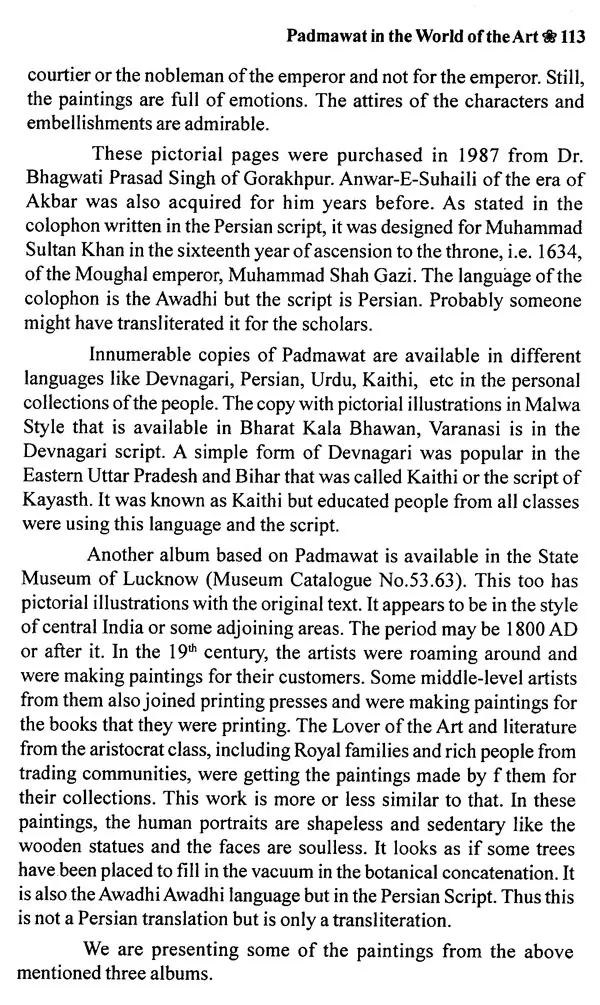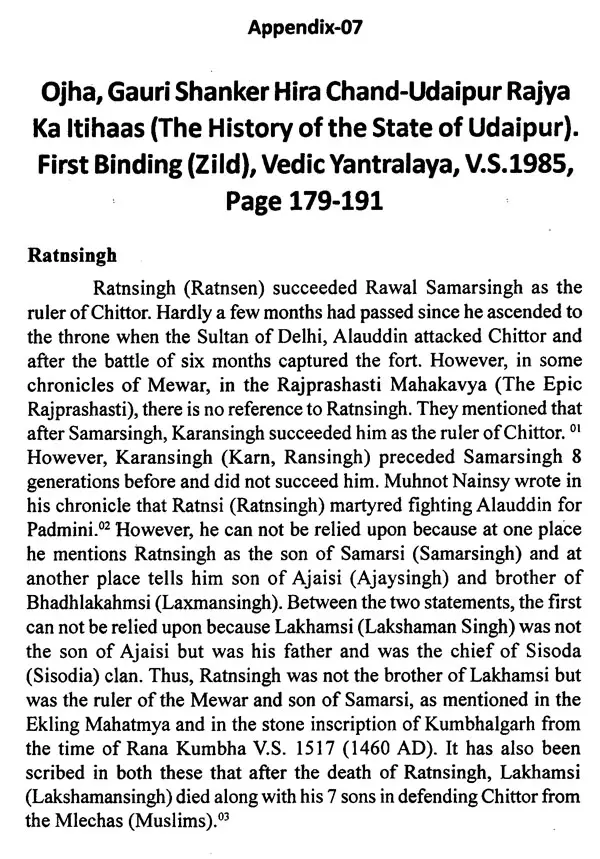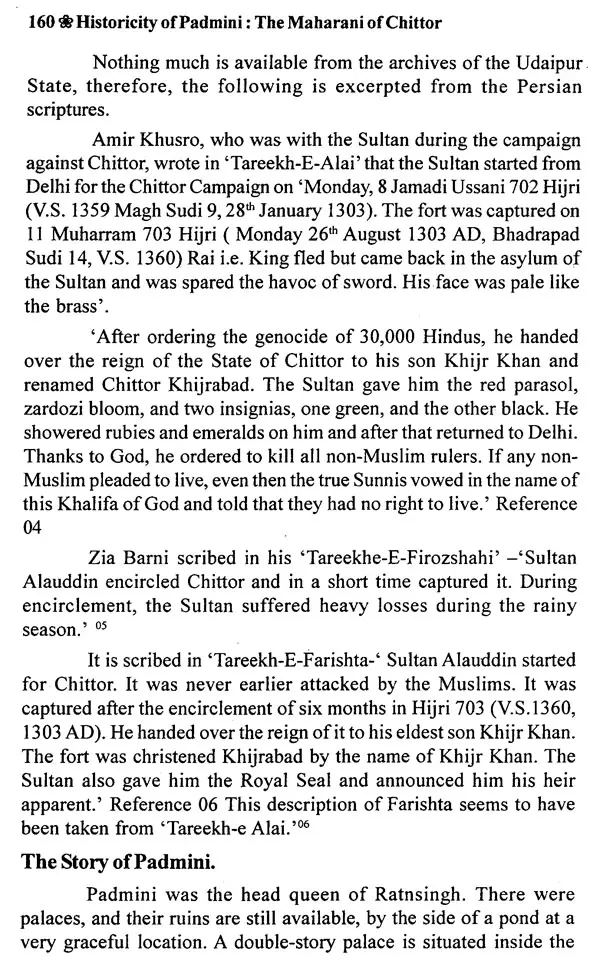
Historicity of Padmini- The Maharani of Chittor
Book Specification
| Item Code: | UAE308 |
| Author: | Chandramani Singh and Surendra Bothra |
| Publisher: | Rajasthani Granthagar, Jodhpur |
| Language: | English |
| Edition: | 2022 |
| ISBN: | 9789391446161 |
| Pages: | 245 |
| Cover: | PAPERBACK |
| Other Details | 8.50 X 5.50 inch |
| Weight | 310 gm |
Book Description
To protect one's motherland and progeny, to keep one's pride and identity intact and to be committed to face the attack on the truth and pride of one's clan is the nature of man, it is a natural quality. Some communities and clans give so much importance to it that they do not hesitate to even sacrifice their lives. His sacrifice is appreciated and glorified in almost all cultures.
Political historians keep on debating, digging through such poignant incidents, but overcoming all such obstacles, such a sacrifice of Padmini of Chittor and her family came out of their stronghold with the flow of time through folklore and folk arts from Mewar and Rajputana. Through this it spread all over India. Today this saga has become a part of the heritage of human culture.
Padmini's fame spread all around. Sufi poet Jayasi wrote Padmavat in Awadhi dialect, from Awadhi it was translated into Deccani Hindi, as well as compositions based on this saga started happening in the South as well. In the 17th century, bilingual works began to appear, especially for Rajput Mansabdars, such books were written in both Persian and Devanagari scripts. Such books are available in the collections of the kings of Amber. From the 16th to the 19th century, reproductions continued to be made and the painters continued to write the story of Padmini. Jogi-singers kept singing it, neither the writing of poets and writers stopped nor painters of painters.
Dr. (Mrs.) Chandramani Singh
The Art Historian, Dr. (Mrs.) Chandramani Singh has been writing for last half century on the contribution of women in the culture, art, literature, and society of India. Some of her major works are Museum of Rajasthan, Textiles and Costumes from Maharaja Sawai Mansingh Sanghralay, Women of Rajasthan, Protected Monuments of Rajasthan, Jaipur Rajya ka ltihas (History of Jaipur State), etc. She made the beginning in the field of Museums from Bhartiya Kala Bhawan Sanghralay of Kashi Hindu University but later Jaipur became her area of activity. She worked as Registrar of City Palace, Jaipur, Founder Director for Restoration of Jaipur Fort and Museum Situated in it, and also as Director Documentation of Jawahar Kala Kendra, an art center established by Government of Rajasthan. Presently associated with Prakrit Bharti Academy, she is presenting in this book her views on the historicity of the Queen of Chittor (Maharani of Chittor), Padmini.
Mr. Surendra Bothra
He is from a prominent business family. He was interested in literature from his student life. He started writing in Hindi and English from the decade of sixties. His articles, poems, and satires are being published in different prominent magazines. He profoundly studied Jainism. In addition to his popular work, Ahimsa: The Science of Peace, translations of fifteen Jain Texts (Agam), Acharang Sutra, Bhagwati Sutra, Dasvaikalik Sutra, Uttradhyayan Sutra, etc. have been published. He is dedicated to bridge the gap between ancient wealth of Jainism and the modern world.
Ashok Kumar Mohnot
He is scholar having translated several Hindi books in English, such as Ahimsa Vishvakosh (Encyclopedia of Nonviolence), Padmini ki Aitihasikata, Goshalak etc. As a banker of repute, he has worked in India and for a while abroad also. He is a retired banker.
About two years ago, the debate in Prakrit Bharati about Sanjay Leela Bhansali's movie had intensified. The litterateurs and other persons related to the society, who used to visit it were expressing their views on the subject. In such an environment a burning question emerged whether Padmini (Padmavati) existed or was she only an imaginary personality? Many great historians have earlier expressed their views on the subject. Some consider her to be a historical person while others concluded that she never existed in history because no documentary evidence of her existence is available. Malik Muhammad Jaisi simply conceived this imaginary character for his love epic Padmavat'.
It was then decided that a lot has been written about it in the past and historians have split into two factions and have divided opinions. Therefore, why should not the new material that has emerged in recent times be meticulously analyzed and an authentic book should be brought out that contains this new and researched information. The responsibility for this was taken up by Dr. Chandra Mani Singh and Mr. Surendra Bothra. It was decided to give preference to research and include, to the extent possible, available literary and art material regarding Padmini in it.
A special request was made to Dr. Chandra Mani Singh, who is an authority on the subject. When Government wanted to decide to grant permission for the release of the movie Padmavat, it invited three prominent persons, Dr. Chandra Mani Singh, and the Ex-Ruler of Udaipur historian Kapil Kumar to give their opinion. The permission was granted only after ascertaining their opinion. Besides Dr. Chadfra Mani Singh, Mr. Surendra Bothra, who is a scholar of Jain Philosophy and History, was also specially requested to join the project. We are happy that both accomplished the task with diligence.
When the work of history of Rajasthan of Colonel James Todd was published in the 19th Century, Indian historians pointed certain contradictions in it and they accused that his work is based on the contents in folklores of Bards, folksingers, and Commendation Singers of Rulers and therefore are mere imaginary stories and are not credible.
Kalika Ranjan Kanungo and K.S. Lal were the main spoke persons of this group. They, in the absence of evidence from the period of Alauddin, believed that Padmini was a mere imaginary character and was not a historic person.
Other historians, like Maha Mahopadhyaya Gauri Shanker Hira Chand Ojha, believed that Padmini was a historic character. They proved that her mention in Padmavat was not the first time. Her reference was available in Aural Traditions (Oral Traditions) since inception after the event of an attack by Alauddin on Chittor (Chitai Varta). They also give examples of local (Regional) literature where she has been repeatedly mentioned. They also opined that oral (Aural) history cannot just be brushed aside.
Jains and Buddhists also have been contributing for a long time to enrich Indian culture. Despite destruction by foreign invaders, huge collections of their literature are available. The earliest of three proofs of the existence of Rawal Ratnsen and Padmini has been discovered-the book of Jain Saint Kakksuri (Kakk Suri) `Nabhinandan Jinodhhar'(from the period 205 years before Jaisi), a composition in the Dingle Language, `Gora Badal Kavitt' in the book of Bhanwar Lal Nahata, `Padmini Charitra Chaupai' (from the period 140-120 years before Jaisi), and the book Chitai Charit' edited by Bhanwar Lal Nahata (from the period 97-87 years before Jaisi).
It is necessary to say something about traditions and oral history (Aural or Oral Traditions). It is believed that popular Aural (Oral) traditions are never false, they are certainly based on reality. The event that has been embedded in the minds of millions of people for centuries, cannot be simply brushed aside calling it preposterous or mere falsehood. Over time, some events and stories make their place in Aural (Oral) Traditions. These are called `interpolation'in literature. With time, certain facts naturally get omitted. We have to remove the doubts that cover the facts due to the passage of a long period and then assess the facts about the real events and persons in true perspective and with proper background to reach a right and unbiased conclusion.
Jaisi certainly composed an imaginary story by decorating his epic in the colors of Sufi Philosophy, but it was based on historical events and characters present in popular Aural (Oral) Traditions. Is it not improper to consider Padmavati (Padmini) due to slight aberration in the name, when the existence of the Sultan of Delhi, Alauddin Khilji, the Ruler of Mewar, Rawal Ratnsen, Tantrik (Exorcist) Raghav Chetan, and feudal lords (Samant) of Ratnsen, Gora and Badal, are, beyond any doubt, historical characters. It is certainly wrong to term it mere imagination of Jaisi.
People associated with research realized that in the initial writeups, historians ignored old literature of Hindi and local languages of Rajasthan, Aural (Oral) Traditions were all together dumped. Aural Traditions were simply rejected without anyexamination. Therefore, the history that was available in the literature was over looked. In the absence of dates, literary works were not considered authentic, while the right way was to analyze the facts available from Aural (Oral) Traditions and undated literary material and bring them into the light for the public.
The time/period of composition of old literature of Hindi and the local languages of Rajasthan should have been ascertained in consultation with the linguists and should then have been given the deserved position in history. For example, historians did not care to obtain the information about Gora Badal Kavit'that was compiled in the work of Bhanwar Lal Nahata, `Padmini Charitr Chaupai', the oldest available text about Padmini, nothing to say of utilizing it.
They never made any mention of the importance of Aural Traditions. As an oral story, the account of events regarding Padmini was popular from the beginning and when the paper was invented and became available easily, the writings also commenced. Then, Chitai Varta and other works were written. Many manuscripts of the story were also prepared and have now been discovered.
This book has been composed keeping in mind all these facts. In addition to analysis and assessment, a lot of material has been included as appendices that is far more extensive and old than what is available in the texts published till now. We hope that learned readers would like it.
Hearty Thanks to editors and their associates. Thanks also to all other people associated with the publication of the book.
**Contents and Sample Pages**
